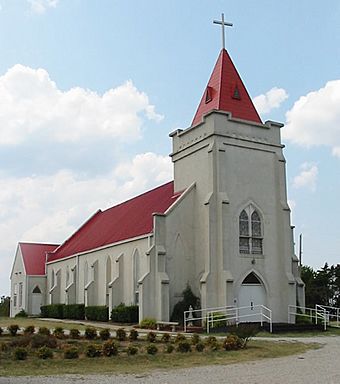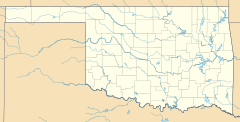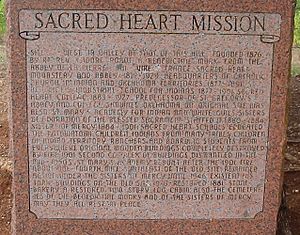Sacred Heart, Oklahoma facts for kids
Quick facts for kids
Sacred Heart
|
|
|---|---|
| Country | United States |
| State | Oklahoma |
| County | Pottawatomie |
| Time zone | UTC-6 (Central (CST)) |
| • Summer (DST) | UTC-5 (CDT) |
|
Sacred Heart Mission Site
|
|

Sacred Heart Church
|
|
| Lua error in Module:Location_map at line 420: attempt to index field 'wikibase' (a nil value). | |
| Nearest city | Asher, Oklahoma |
|---|---|
| Area | 640 acres (260 ha) |
| Built | 1914 |
| NRHP reference No. | 83002125 |
| Added to NRHP | September 15, 1983 |
Sacred Heart is a small, unincorporated community in Pottawatomie County, Oklahoma. An unincorporated community is a place that is not part of an official city or town. It was started in 1879 by Father Isidore Robot. He created it as a Catholic mission on the old Pottawatomie tribal land.
It was first called Sacred Heart Mission. The name changed to Sacred Heart in 1888. This was just before the land was opened for other people to settle there. The community grew around the Sacred Heart Mission. Over time, many of its activities moved to other places. For example, high school and college education for boys moved to Shawnee in 1915. This facility later became St. Gregory's University. The local post office closed in 1954. Today, Sacred Heart is considered a ghost town, meaning most people have left.
Contents
History of Sacred Heart
How Sacred Heart Started
In October 1876, Father Isidore Robot made an agreement with the Potawatomi people. He got land for the Sacred Heart Mission. Starting the mission was hard work. The first Mass (a Christian church service) at Sacred Heart happened on May 13, 1877. However, people didn't live there all the time until June 7, 1877. This date is seen as the real start of the mission.
In 1880, the Saint Mary's Academy was built for girls' education. A boarding school for boys, the Sacred Heart Institute, also opened. By 1884, the mission had many buildings. These included a convent, a girls' school, stables, and a blacksmith shop. There was also a bakery where the Sisters made 500 French loaves every day. A large farm was also created. It had orchards, gardens, vineyards, and many animals. The farm helped feed the mission and taught farming skills to the Native American boys. The mission even had its own newspaper, the Indian Advocate. It was printed from 1888 to 1910 in the bakery building. In 1884, Sacred Heart College opened, offering education for older boys.
The 1901 Fire
On January 15, 1901, a big fire started in the dining room of the boys' school. The fire quickly spread out of control. It destroyed many buildings, including the monastery, both schools, the college, the convent, and the church. Luckily, no one was killed in the fire. Only a few small buildings were left. The bakery and a two-story log cabin are the only original buildings still standing today.
After the fire, temporary wooden buildings were set up for the boys' school. The Sisters of Mercy moved nearby to start a new St. Mary's Academy. Church services were held in a converted granary. The current church building was started in 1905 and finished in 1914.
By 1910, the Benedictine monks from Sacred Heart began building St. Gregory's College in Shawnee. A large building called Benedictine Hall was built there. It opened in 1915 for high school and college students. An elementary school for boys stayed at Sacred Heart until 1926. Sacred Heart was the main center for the Benedictines for many years. Later, this role moved to Mt. Saint Mary's in Oklahoma City. By the early 1930s, most of the educational and religious activities had moved to St. Gregory's College. The Sisters of Mercy also started many schools and hospitals across Oklahoma.
Sacred Heart became a priory (a smaller monastery) after other activities moved away. The priory closed for good in 1965. The church is still there, but most other buildings have been torn down.
What Sacred Heart Looks Like Today
The Sacred Heart site still has some buildings and ruins.
The most important building is the Sacred Heart Catholic Church. It was finished in 1914. The church sits on top of Bald Hill, which is the highest point in Pottawatomie County. It has a simple Gothic Revival style with a red tile roof and a short front tower. Near the church are two cemeteries. One is for the Sisters, and one is for the abbey (monastery). Other old buildings include one- and two-story log houses from the late 1800s. There is also a two-story sandstone bakery. You can still see the foundations of the old school buildings. The site was added to the National Register of Historic Places on September 15, 1983.




